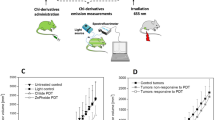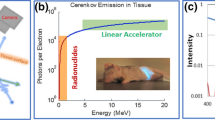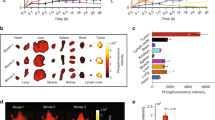Abstract
Understanding of the biology of photodynamic therapy (PDT) has expanded tremendously over the past few years. However, in the clinical situation, it is still a challenge to match the extent of PDT effects to the extent of the disease process being treated. PDT requires drug, light and oxygen, any of which can be the limiting factor in determining efficacy at each point in a target organ. This article reviews techniques available for monitoring tissue oxygenation during PDT. Point measurements can be made using oxygen electrodes or luminescence-based optodes for direct measurements of tissue pO2, or using optical spectroscopy for measuring the oxygen saturation of haemoglobin. Imaging is considerably more complex, but may become feasible with techniques like BOLD MRI. Pre-clinical studies have shown dramatic changes in oxygenation during PDT, which vary with the photosensitiser used and the light delivery regimen. Better oxygenation throughout treatment is achieved if the light fluence rate is kept low as this reduces the rate of oxygen consumption. The relationship between tissue oxygenation and PDT effect is complex and remarkably few studies have directly correlated oxygenation changes during PDT with the final biological effect, although those that have confirm the value of maintaining good oxygenation. Real time monitoring to ensure adequate oxygenation at strategic points in target tissues during PDT is likely to be important, particularly in the image guided treatment of tumours of solid organs.
Similar content being viewed by others
References
J. Moan, S. Sommer, Oxygen dependence of the photosensitizing effect of hematoporphyrin derivative in NHIK 3025 cells, Cancer Res., 1985, 45, 1608–1610.
J. B. Mitchell, S. McPherson, W. DeGraff, J. Gamson, A. Zabell, A. Russo, Oxygen dependence of hematoporphyrin derivative-induced photoinactivation of Chinese hamster cells, Cancer Res., 1985, 45, 2008–2011.
S. K. Lee, I. J. Forbes, W. H. Betts, Oxygen dependency of photocytotoxicity with haematoporphyrin derivative, Photochem. Photobiol., 1984, 39, 631–634.
M. G. Nichols, T. H. Foster, Oxygen diffusion and reaction kinetics in the photodynamic therapy of multicell tumour spheroids, Phys. Med. Biol., 1994, 39, 2161–2181.
I. Georgakoudi, M. G. Nichols, T. H. Foster, The mechanism of Photofrin photobleaching and its consequences for photodynamic dosimetry, Photochem. Photobiol., 1997, 65, 135–144.
T. M. Sitnik, J. A. Hampton, B. W. Henderson, Reduction of tumour oxygenation during and after photodynamic therapy in vivo: effects of fluence rate, Br. J. Cancer, 1998, 77, 1386–1394.
B. W. Henderson, T. M. Busch, L. A. Vaughan, N. P. Frawley, D. Babich, T. A. Sosa, J. D. Zollo, A. S. Dee, M. T. Cooper, D. A. Bellnier, W. R. Greco, A. R. Oseroff, Photofrin photodynamic therapy can significantly deplete or preserve oxygenation in human basal cell carcinomas during treatment, depending on fluence rate, Cancer Res., 2000, 60, 525–529.
G. Yu, T. Durduran, C. Zhou, H. W. Wang, M. E. Putt, H. M. Saunders, C. M. Sehgal, E. Glatstein, A. G. Yodh, T. M. Busch, Noninvasive monitoring of murine tumor blood flow during and after photodynamic therapy provides early assessment of therapeutic efficacy, Clin. Cancer Res., 2005, 11, 3543–3552.
T. H. Foster, R. S. Murant, R. G. Bryant, R. S. Knox, S. L. Gibson, R. Hilf, Oxygen consumption and diffusion effects in photodynamic therapy, Radiat. Res., 1991, 126, 296–303.
J. P. Henning, R. L. Fournier, J. A. Hampton, A transient mathematical model of oxygen depletion during photodynamic therapy, Radiat. Res., 1995, 142, 221–226.
H. W. Wang, M. E. Putt, M. J. Emanuele, D. B. Shin, E. Glatstein, A. G. Yodh, T. M. Busch, Treatment-induced changes in tumor oxygenation predict photodynamic therapy outcome, Cancer Res., 2004, 64, 7553–7561.
B. W. Pogue, J. A. O’Hara, I. A. Goodwin, C. J. Wilmot, G. P. Fournier, A. R. Akay, H. Swartz, Tumor PO(2) changes during photodynamic therapy depend upon photosensitizer type and time after injection, Comp. Biochem. Physiol., A: Physiol., 2002, 132, 177–184.
T. M. Busch, E. P. Wileyto, S. M. Evans, C. J. Koch, Quantitative spatial analysis of hypoxia and vascular perfusion in tumor sections, Adv. Exp. Med. Biol., 2003, 510, 37–43.
H. M. Swartz, Measuring real levels of oxygen in vivo: opportunities and challenges, Biochem. Soc. Trans., 2002, 30, 248–252.
L. C. Clark, E. W. Clark, A personalized history of the Clark oxygen electrode, Int. Anesthesiol. Clin., 1987, 25, 1–29.
D. F. Wilson, J. M. Vanderkooi, T. J. Green, G. Maniara, S. P. DeFeo, D. C. Bloomgarden, A versatile and sensitive method for measuring oxygen, Adv. Exp. Med. Biol., 1987, 215, 71–77.
D. F. Wilson, Oxygen dependent quenching of phosphorescence: a perspective, Adv. Exp. Med. Biol., 1992, 317, 195–201.
B. W. McIlroy, A. Curnow, G. Buonaccorsi, M. A. Scott, S. G. Bown, A. J. MacRobert, Spatial measurement of oxygen levels during photodynamic therapy using time-resolved optical spectroscopy, J. Photochem. Photobiol., B, 1998, 43, 47–55.
S. A. Vinogradov, L. W. Lo, W. T. Jenkins, S. M. Evans, C. Koch, D. F. Wilson, Noninvasive imaging of the distribution in oxygen in tissue in vivo using near-infrared phosphors, Biophys. J., 1996, 70, 1609–1617.
M. W. Reed, A. P. Mullins, G. L. Anderson, F. N. Miller, T. J. Wieman, The effect of photodynamic therapy on tumor oxygenation, Surgery, 1989, 106, 94–99.
B. J. Tromberg, A. Orenstein, S. Kimel, S. J. Barker, J. Hyatt, J. S. Nelson, M. W. Berns, In vivo tumor oxygen tension measurements for the evaluation of the efficiency of photodynamic therapy, Photochem. Photobiol., 1990, 52, 375–385.
Q. Chen, Z. Huang, H. Chen, H. Shapiro, J. Beckers, F. W. Hetzel, Improvement of tumor response by manipulation of tumor oxygenation during photodynamic therapy, Photochem. Photobiol., 2002, 76, 197–203.
B. W. Pogue, R. D. Braun, J. L. Lanzen, C. Erickson, M. W. Dewhirst, Analysis of the heterogeneity of pO2 dynamics during photodynamic therapy with verteporfin, Photochem. Photobiol., 2001, 74, 700–706.
A. Curnow, J. C. Haller, S. G. Bown, Oxygen monitoring during 5-aminolaevulinic acid induced photodynamic therapy in normal rat colon. Comparison of continuous and fractionated light regimes, J. Photochem. Photobiol., B, 2000, 58, 149–155.
P. Babilas, V. Schacht, G. Liebsch, O. S. Wolfbeis, M. Landthaler, R. M. Szeimies, C. Abels, Effects of light fractionation and different fluence rates on photodynamic therapy with 5-aminolaevulinic acid in vivo, Br. J. Cancer, 2003, 88, 1462–1469.
H. Schouwink, H. Oppelaar, M. Ruevekamp, d. van, V. G. Hart, P. Rijken, P. Baas, F. A. Stewart, Oxygen depletion during and after mTHPC-mediated photodynamic therapy in RIF1 and H-MESO1 tumors, Radiat. Res., 2003, 159, 190–198.
S. Coutier, L. N. Bezdetnaya, T. H. Foster, R. M. Parache, F. Guillemin, Effect of irradiation fluence rate on the efficacy of photodynamic therapy and tumor oxygenation in meta-tetra (hydroxyphenyl) chlorin (mTHPC)-sensitized HT29 xenografts in nude mice, Radiat. Res., 2002, 158, 339–345.
J. Zilberstein, A. Bromberg, A. Frantz, V. Rosenbach-Belkin, A. Kritzmann, R. Pfefermann, Y. Salomon, A. Scherz, Light-dependent oxygen consumption in bacteriochlorophyll-serine-treated melanoma tumors: on-line determination using a tissue-inserted oxygen microsensor, Photochem. Photobiol., 1997, 65, 1012–1019.
B. Chen, B. Ahmed, W. Landuyt, Y. Ni, R. Gaspar, T. Roskams, P. A. de Witte, Potentiation of photodynamic therapy with hypericin by mitomycin C in the radiation-induced fibrosarcoma-1 mouse tumor model, Photochem. Photobiol., 2003, 78, 278–282.
A. Johansson, T. Johansson, M. S. Thompson, N. Bendsoe, K. Svanberg, S. Svanberg, S. Andersson-Engels, In vivo measurement of parameters of dosimetric importance during interstitial photodynamic therapy of thick skin tumors, J. Biomed. Opt., 2006, 11, 34029.
G. Yu, T. Durduran, C. Zhou, T. C. Zhu, J. C. Finlay, T. M. Busch, S. B. Malkowicz, S. M. Hahn, A. G. Yodh, Real-time in situ monitoring of human prostate photodynamic therapy with diffuse light, Photochem. Photobiol., 2006, 82, 1279–1284.
A. Amelink van der Ploeg van den Heuvel, W. J. de Wolf, D. J. Robinson, H. J. Sterenborg, Monitoring PDT by means of superficial reflectance spectroscopy, J. Photochem. Photobiol., B, 2005, 79, 243–251.
H. W. Wang, T. C. Zhu, M. E. Putt, M. Solonenko, J. Metz, A. Dimofte, J. Miles, D. L. Fraker, E. Glatstein, S. M. Hahn, A. G. Yodh, Broadband reflectance measurements of light penetration, blood oxygenation, hemoglobin concentration, and drug concentration in human intraperitoneal tissues before and after photodynamic therapy, J. Biomed. Opt., 2005, 10, 14004.
G. Kostenich, S. Kimel, S. Peled, A. Orenstein, Monitoring PDT-induced damage using spectrally resolved reflectance imaging of tissue oxygenation, Cancer Lett., 2005, 219, 169–175.
M. S. Thompson, A. Johansson, T. Johansson, S. Andersson-Engels, S. Svanberg, N. Bendsoe, K. Svanberg, Clinical system for interstitial photodynamic therapy with combined on-line dosimetry measurements, Appl. Opt., 2005, 44, 4023–4031.
J. H. Woodhams, L. Kunz, S. G. Bown, A. J. MacRobert, Correlation of real-time haemoglobin oxygen saturation monitoring during photodynamic therapy with microvascular effects and tissue necrosis in normal rat liver, Br. J. Cancer, 2004, 91, 788–794.
M. Korbelik, J. Sun, H. Zeng, Ischaemia-reperfusion injury in photodynamic therapy-treated mouse tumours, Br. J. Cancer, 2003, 88, 760–766.
M. Solonenko, R. Cheung, T. M. Busch, A. Kachur, G. M. Griffin, T. Vulcan, T. C. Zhu, H. W. Wang, S. M. Hahn, A. G. Yodh, In vivo reflectance measurement of optical properties, blood oxygenation and motexafin lutetium uptake in canine large bowels, kidneys and prostates, Phys. Med. Biol., 2002, 47, 857–873.
A. Dietze, Q. Peng, P. K. Selbo, O. Kaalhus, C. Muller, S. Bown, K. Berg, Enhanced photodynamic destruction of a transplantable fibrosarcoma using photochemical internalisation of gelonin, Br. J. Cancer, 2005, 92, 2004–2009.
H. Schouwink, H. Oppelaar, M. Ruevekamp, d. van, V. G. Hart, P. Rijken, P. Baas, F. A. Stewart, Oxygen depletion during and after mTHPC-mediated photodynamic therapy in RIF1 and H-MESO1 tumors, Radiat. Res., 2003, 159, 190–198.
T. H. Pham, R. Hornung, M. W. Berns, Y. Tadir, B. J. Tromberg, Monitoring tumor response during photodynamic therapy using near-infrared photon-migration spectroscopy, Photochem. Photobiol., 2001, 73, 669–677.
R. Hornung, T. H. Pham, K. A. Keefe, M. W. Berns, Y. Tadir, B. J. Tromberg, Quantitative near-infrared spectroscopy of cervical dysplasia in vivo, Hum. Reprod., 1999, 14, 2908–2916.
H. M. Swartz, T. Walczak, Developing in vivo EPR oximetry for clinical use, Adv. Exp. Med. Biol., 1998, 454, 243–252.
H. M. Swartz, R. B. Clarkson, The measurement of oxygen in vivo using EPR techniques, Phys. Med. Biol., 1998, 43, 1957–1975.
B. W. Pogue, J. A. O’Hara, K. J. Liu, T. Hasan, H. Swartz, Photodynamic treatment of the RIF-1 tumor with verteporfin with online monitoring of tissue oxygen using electron paramagnetic resonance oximetry, Laser-Tissue Interaction X: Photochemical, Photothermal, and Photomechanical, Proc. SPIE–Int. Soc. Opt. Eng., 1999, 3601, 108–104.
B. W. Pogue, J. A. O’Hara, E. Demidenko, C. M. Wilmot, I. A. Goodwin, B. Chen, H. M. Swartz, T. Hasan, Photodynamic therapy with verteporfin in the radiation-induced fibrosarcoma-1 tumor causes enhanced radiation sensitivity, Cancer Res., 2003, 63, 1025–1033.
T. M. Busch, Local physiological changes during photodynamic therapy, Lasers Surg. Med., 2006, 38, 494–499.
R. Turner, Signal sources in bold contrast fMRI, Adv. Exp. Med. Biol., 1997, 413, 19–25.
S. Gross, A. Gilead, A. Scherz, M. Neeman, Y. Salomon, Monitoring photodynamic therapy of solid tumors online by BOLD-contrast MRI, Nat. Med., 2003, 9, 1327–1331.
J. D. Chapman, M. S. McPhee, N. Walz, M. P. Chetner, C. C. Stobbe, K. Soderlind, M. Arnfield, B. E. Meeker, L. Trimble, P. S. Allen, Nuclear magnetic resonance spectroscopy and sensitizer-adduct measurements of photodynamic therapy-induced ischemia in solid tumors, J. Natl. Cancer Inst., 1991, 83, 1650–1659.
R. Springett, H. M. Swartz, Measurements of oxygen in vivo: overview and perspectives on methods to measure oxygen within cells and tissues, Antioxid. Redox Signal., 2007, 9, 1295–1302.
M. B. Ericson, C. Sandberg, B. Stenquist, F. Gudmundson, M. Karlsson, A. M. Ros, A. Rosen, O. Larko, A. M. Wennberg, I. Rosdahl, Photodynamic therapy of actinic keratosis at varying fluence rates: assessment of photobleaching, pain and primary clinical outcome, Br. J. Dermatol., 2004, 151, 1204–1212.
A. Maier, F. Tomaselli, U. Anegg, P. Rehak, B. Fell, S. Luznik, H. Pinter, F. M. Smolle-Juttner, Combined photodynamic therapy and hyperbaric oxygenation in carcinoma of the esophagus and the esophago-gastric junction, Eur. J. Cardiothorac. Surg., 2000, 18, 649–654.
J. H. Woodhams, PhD Thesis, 2006.
A. Curnow, B. W. McIlroy, M. J. Postle-Hacon, A. J. MacRobert, S. G. Bown, Light dose fractionation to enhance photodynamic therapy using 5-aminolevulinic acid in the normal rat colon, Photochem. Photobiol., 1999, 69, 71–76.
B. W. Henderson, T. M. Busch, J. W. Snyder, Fluence rate as a modulator of PDT mechanisms, Lasers Surg. Med., 2006, 38, 489–493.
A. Tremblay, S. Leroy, L. Freitag, M. C. Copin, P. H. Brun, C. H. Marquette, Endobronchial phototoxicity of WST 09 (Tookad), a new fast-acting photosensitizer for photodynamic therapy: preclinical study in the pig, Photochem. Photobiol., 2003, 78, 124–130.
S. Mitra, T. H. Foster, Carbogen breathing significantly enhances the penetration of red light in murine tumours in vivo, Phys. Med. Biol., 2004, 49, 1891–1904.
Author information
Authors and Affiliations
Rights and permissions
About this article
Cite this article
Woodhams, J.H., MacRobert, A.J. & Bown, S.G. The role of oxygen monitoring during photodynamic therapy and its potential for treatment dosimetry. Photochem Photobiol Sci 6, 1246–1256 (2007). https://doi.org/10.1039/b709644e
Received:
Accepted:
Published:
Issue Date:
DOI: https://doi.org/10.1039/b709644e




